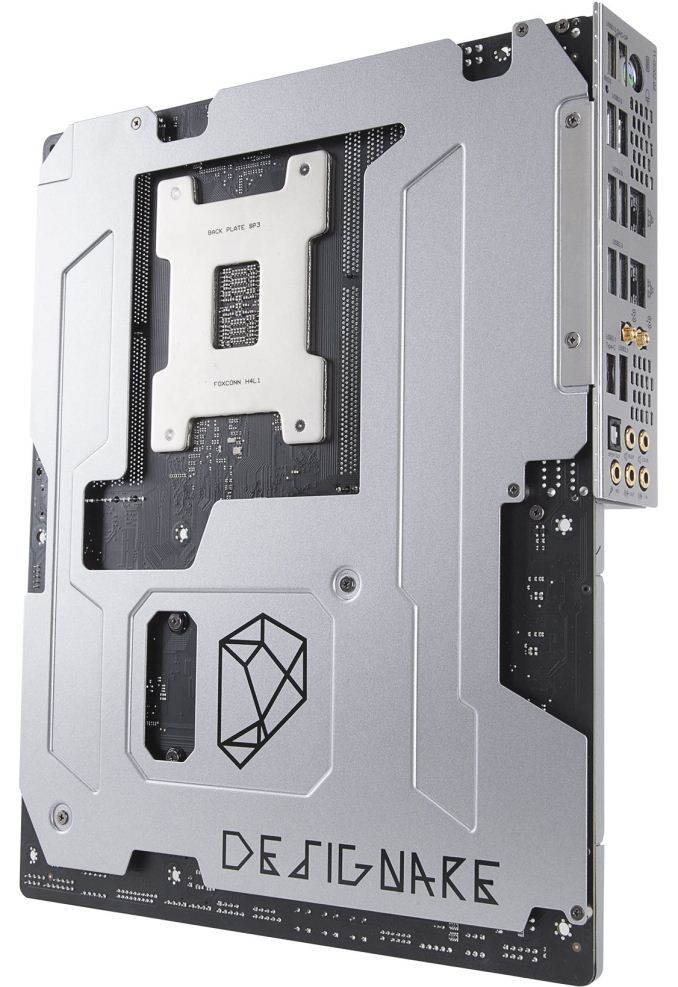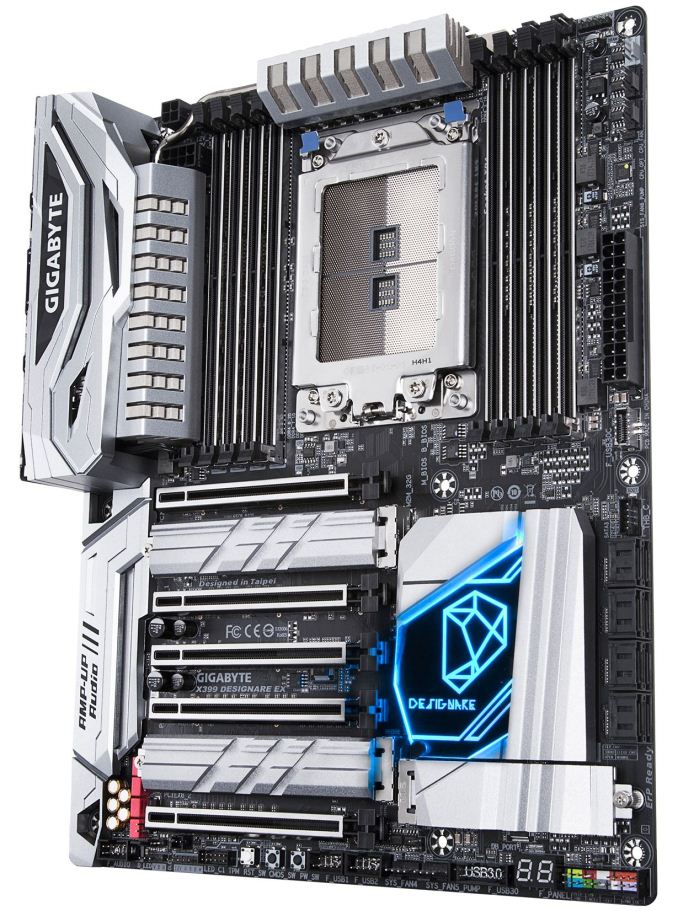An AMD Threadripper X399 Motherboard Overview: A Quick Look at Seven Products
by Ian Cutress & Joe Shields on September 15, 2017 9:00 AM ESTAdded 9/19: GIGABYTE X399 Designare-EX
One of the first things one may notice on this board is lack of RGB LEDs compared with the AORUS Gaming 7. On the Gaming 7, where RGB LEDs are just about everywhere, the Designare EX on the other hand only has a few under the PCH heatsink. Aside from that, design aesthetics are remarkably similar, with only the color scheme changed from black colored heatsinks and shrouds (with the AORUS name) to all silver, and the GIGABYTE name on the shrouds instead. The PCH heatsink is the same shape with a different accent plate for the Designare, marking a not to GIGABYTE's aimed market for this product: design professionals. Also included is an integrated I/O shield giving it a more high-end feel.
Outside of what has been listed above, the specifications for the Designare are very similar to the Gaming 7, as it uses the same base PCB. Keeping on the platform trend, the Designare EX supports quad channel memory at two DIMMs per channel, for eight total supporting up to 128GB. What looks like an 8-phase VRM uses the same style main heatsink connected to a secondary heatsink via a heat pipe located behind the rear I/O. Being the same PCB, the power delivery is also listed as ‘server class’ like the Gaming 7, using fourth generation International Rectifier (IR) PWM controllers and third generation PowIRstage chokes. EPS power is found in its normal location in the top left corner of the board, with one 8-pin and one 4-pin.
In the top right corner of the board are five 4-pin fan headers along with an RGBW header for LEDs. Two other RGB headers are found across the bottom of the board, including another RGBW header. USB connectivity uses an onboard USB 3.1 (10Gbps) header from the chipset close to the eight SATA ports. There is a USB 3.0 header on the bottom of the board, two USB 2.0 headers near the power buttons, and a TPM header at the bottom of the board.
Like the AORUS Gaming 7, the Designare EX supports three M.2 drives. The two locations between the PCIe slots support up to 110mm long drives, while the third below the PCH heatsink can fit up to 80mm drives. All locations come with additional heatsinks to keep the drives underneath cool. The Designare EX uses the three M.2 slots instead of a separate U.2 connector. For other storage, GIGABYTE has equipped the board with eight SATA ports. The 5-pin Thunderbolt 3 header, required for add-in Thunderbolt 3 cards and unique for X399 to this specific GIGABYTE X399 board, is located just above the SATA ports. We are asking GIGABYTE if they plan to bundle a Thunderbolt 3 add-in card with this model, and are awaiting a response.
The rear of the motherboard, like some other designs on the market, uses a rear backplate to assist with motherboard rigidity. The thinking here is that these motherboards are often used in systems with multiple heavy graphics cards or PCIe coprocessors, such that if a motherboard screw is incorrectly tightened, the motherboard might be required to take the load and eventually warp. With the back-plate in place, this is designed to distribute that potential extra torque throughout the PCB, minimising any negative effects.
The PCIe slots are the same as the Gaming 7 also, with four of the five sourcing its lanes directly from the CPU. The slots used for GPUs are double-spaced and support an x16/x8/x16/x8 arrangement. The middle slot supports PCIe 3.0 x4 connection fed from the chipset. The middle slot can be used for additional add-in cards, such as a Thunderbolt 3 card.
Next to the PCIe slots is GIGABYTE’s audio solution, using a Realtek ALC1220 codec and using an EMI shield, PCB separation for the digital and analog audio signals, filter caps (both WIMA and Nichicon), and has headphone hack detection. GIGABYTE also uses DAC-UP, which delivers a more consistent USB power supply for USB connected audio devices.
Rear IO connectivity on the Designare EX is also like the AORUS Gaming 7. The only difference will be the additional Ethernet port as this model uses dual Intel NICs. Because of the USB 3.0 support from the CPU, the rear IO has eight USB ports, in yellow, blue, and white. There are also two USB 3.1 (10 Gbps) ports from the chipset, one USB Type-C. Network connectivity differs here with the Designare EX using two Intel NICs (we imagine some mixture of I219V or I211AT) and does away with the Rivet Networks Killer E2500 found on its little brother. Last, are a set of audio jacks including SPDIF.
Pricing was not listed, however, if it is slated to be the flagship of the X399 lineup, pricing is expected to be a higher than the already released X399 AORUS Gaming 7 at $389.99 on Amazon. GIGABYTE says the Designare EX will be available come Mid-October.
| GIGABYTE X399 Designare EX | |
| Warranty Period | 3 Years |
| Product Page | N/A |
| Price | TBD |
| Size | ATX |
| CPU Interface | TR4 |
| Chipset | AMD X399 |
| Memory Slots (DDR4) | Eight DDR4 Supporting 128GB Quad Channel Support DDR4 3600+ Support for ECC UDIMM (in non-ECC mode) |
| Network Connectivity | 2 x Intel LAN 1 x Intel 2x2 802.11ac |
| Onboard Audio | Realtek ALC1220 |
| PCIe Slots for Graphics (from CPU) |
2 x PCIe 3.0 x16 slots @ x16 2 x PCIe 3.0 x16 slots @ x8 |
| PCIe Slots for Other (from Chipset) |
1 x PCIe 2.0 x16 slots @ x4 |
| Onboard SATA | 8 x Supporting RAID 0/1/10 |
| Onboard SATA Express | None |
| Onboard M.2 | 3 x PCIe 3.0 x4 - NVMe or SATA |
| Onboard U.2 | None |
| USB 3.1 | 1 x Type-C (ASMedia) 1 x Type-A (ASMedia) |
| USB 3.0 | 8 x Back Panel 1 x Header |
| USB 2.0 | 2 x Headers |
| Power Connectors | 1 x 24-pin EATX 1 x 8-pin ATX 12V 1 x 4-pin ATX 12V |
| Fan Headers | 1 x CPU 1 x Watercooling CPU 4 x System Fan headers 2 x System Fan/ Water Pump headers |
| IO Panel | 1 x PS.2 keyboard/mouse port 1 x USB 3.1 Type-C 1 x USB 3.1 Type-A 8 x USB 3.0 2 x RJ-45 LAN Port 1 x Optical S/PDIF out 5 x Audio Jacks Antenna connectors |
Additional News (9/20):
After speaking with GIGABYTE, it seems that Thunderbolt 3 support will perhaps still be in limbo:
Thunderbolt 3 certification requires a few things from the CPU side like graphical output which we haven't been able to do. We expect this will be developed upon through Raven Ridge and possibly get more groundwork down to activate TB3 on the X399 Designare EX.
The header will remain, though TB3 use / full TB3 enablement will be at a later date. It seems like GIGABYTE has taken note that users are interested in TB3 on AMD.




















99 Comments
View All Comments
BoemlauweBas - Friday, October 20, 2017 - link
The fact you still can't buy them is one thing, and it will be expensive. Then again, if money ain't a thing & you'll agree one kidney should be enough for anyway. Buy this for your (Yes, it's in the sales sheet) for you games / media. For the real OG's would go for something like Sandisk's Infiniflash.....I know right .... https://www.youtube.com/watch?v=iWvrOItRSyQ
plonk420 - Tuesday, September 19, 2017 - link
you go fairly high end motherboard, but then you get terrible SATA cards? ಠ_ಠyeah, do like Supermicro (there's a couple cards low $100s) or at least that Adaptec.
just like IDE cards back in the day... buy a crap card, get crap performance.
mapesdhs - Tuesday, September 19, 2017 - link
It's a shame Intel's never made a PCIe card using its own controller, because of course Intel's SATA3 ports on its own boards always work nicely. But then, if they did, loads of people would buy the card to fit to older boards (especially X58, Z68, X79, etc.) instead of upgrading to a newer board, and it'd be cool to have such an option for AMD boards aswell. Never gonna happen though I guess.Oksana - Saturday, September 19, 2020 - link
I really like Thunderbolt, but also want to build a Threadripper computer. Is it possible to have the best of both worlds and add a thunderbolt card?ddriver - Friday, September 15, 2017 - link
It has six. How much do you need? Considering it also has 3 M2 slots.That 10 gbit lan card is for connecting to a proper nas server. You don't cram a workstation with a dozen HDDs.
nathanddrews - Friday, September 15, 2017 - link
I'm not building a workstation.ddriver - Friday, September 15, 2017 - link
So you are building a file server then? Senseless choice of hardware then ;)HomeworldFound - Friday, September 15, 2017 - link
A file server is a good wife excuse to build with a Threadripper. He can pretend he needs one core per hard drive and in order to stream video to more than one TV he needs two GPUs. It works.ddriver - Friday, September 15, 2017 - link
So a dumb wife having to approve your purchases is a realistic scenario? :DHomeworldFound - Friday, September 15, 2017 - link
In my location telling people that you can build a computer makes people want to touch you.